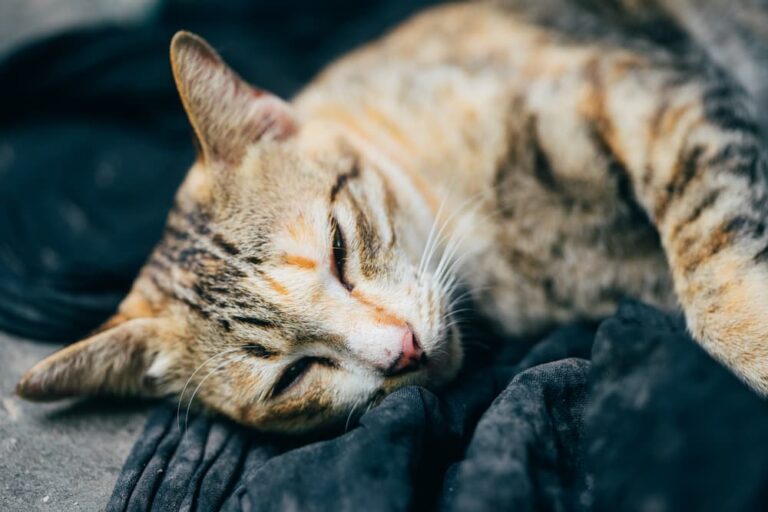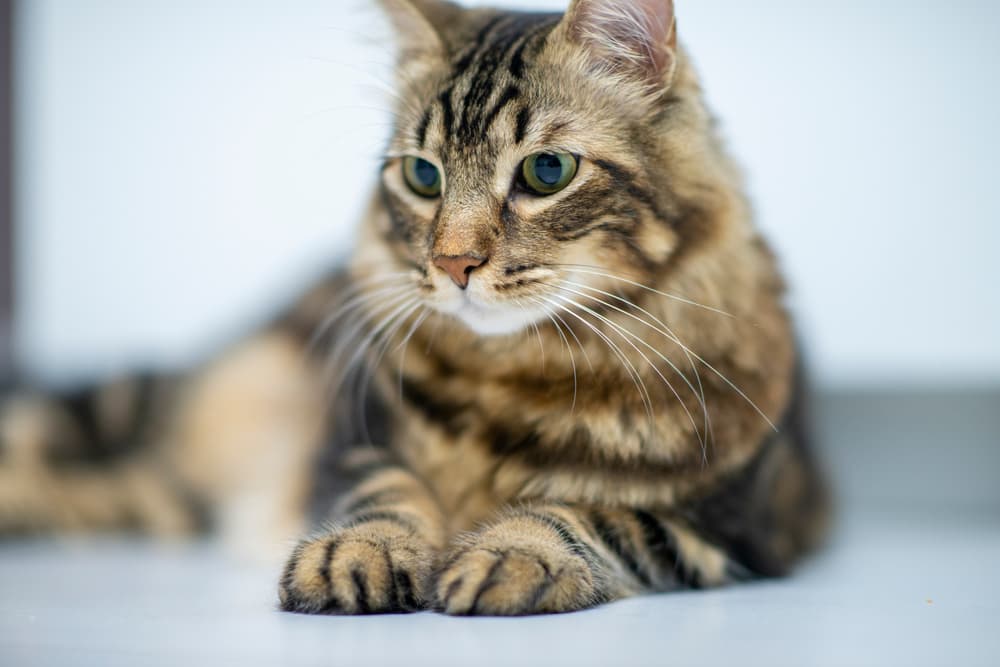Liver Disease in Cats

Overview
- Liver disease in cats is fairly common. Difficulty of treatment depends on the underlying cause of liver disease.
- It can be caused by inflammation, cancer, infections, or lipidosis.
- Symptoms include jaundice, lack of appetite, orange urine, decreased energy, and more.
- Treatment is focused on supportive care, managing symptoms, and eradicating underlying cause if possible
The liver is a very important organ for cats. It does everything from breaking down energy in food to stopping bleeding. Liver disease in cats is fairly common and can result in some devastating consequences. Unfortunately, liver disease can be difficult to treat.
Catching liver disease early is the best way to help your cat. Read more to understand what causes liver disease, how to identify symptoms, and what it takes to treat your cat.
Liver Problems in Cats: An Overview
The liver is a very vital organ to your cat’s overall health. It breaks down nutrients from food into energy and medications into effective treatments. Vitamins and minerals are stored in the liver until a cat’s body needs them. It has many roles in metabolism—meaning the liver helps many processes that are crucial to staying alive.
The liver is found just underneath a cat’s rib cage. A muscle called the diaphragm separates the chest (with the heart and lungs) and the abdomen (with the liver, gastrointestinal system, kidneys, etc). Between the diaphragm and the stomach is the liver. The gallbladder is a structure within the liver, filled with bile that breaks down food. The liver looks like a round, smooth organ with reddish-brown coloration and multiple parts to it, called lobes.
Because the liver provides so many critical processes, if the liver is diseased, it affects the whole body. Energy from food declines, vitamins and minerals are unavailable, the body cannot effectively process medications, bleeding doesn’t stop, and more.
Types of Cat Liver Disease

There are four categories for types of liver disease in cats. These include:
- Inflammatory
- Lipidosis
- Cancer (neoplasia)
- Infectious
All of these types of feline liver disease have extremely similar symptoms, so you cannot tell these apart based on how your cat feels.
Inflammatory means there is inflammation somewhere in the liver. This can be primary or secondary. Primary inflammation means that the liver itself is the reason for the inflammation. However, the liver may be inflamed because of other conditions or even because other nearby or related organs are inflamed. The most common inflammatory liver condition in cats is called cholangiohepatitis, which is primary inflammation involving the gallbladder. These conditions range from mild to severe.
Hepatic lipidosis, also known as fatty liver disease, is when individual liver cells store too much fat, which stops the liver from being able to metabolize food for energy. While overweight cats are at a higher risk of developing this condition (due to having more body fat), cats of healthy weight can also develop lipidosis. When this condition is diagnosed, it is usually considered moderate to severe.
Cancer is a possible cause of liver disease in cats and is usually severe.
Infectious liver disease can be caused by a variety of pathogens (viruses, parasites, and fungi) and is the least common cause of liver disease in cats. It can be mild to severe.
Cats can also suffer from cirrhosis of the liver, but it is rare.
Symptoms of Liver Disease in Cats

Liver disease commonly causes vague symptoms in cats, such as a change in appetite and a change in behavior.
A comprehensive list of possible symptoms include:
- Weight loss
- Decreased (or absent) appetite
- Decreased activity level
- Drooling and/or vomiting
- Diarrhea
- Change in litter box habits
- Change in behavior (ex. Hiding)
- Yellow tinge to the skin and whites of the eyes
- Orange-tinged urine
- Enlargement of the belly (abdomen)
- Increased thirst and/or urination
One of the most specific symptoms of liver disease in cats is icterus, also known as jaundice. Icterus occurs when the skin turns a yellow tint as well as the white parts of the eyes. Icterus is due to a normal byproduct of the liver building up in the body.
However, this process can occur for a couple other issues that do not directly involve the liver, so veterinarians cannot assume there is liver disease even with icterus. Testing is needed to confirm whether this is being caused by your cat’s liver.
Causes of Liver Disease in Cats

One of the most common causes of liver disease in cats is cholangitis also known as cholangiohepatitis. As previously mentioned, this is due to inflammation and it encompasses 25 percent of all cases of feline liver disease.
A theory for why this inflammation happens includes bacteria making its way from the gastrointestinal system to the bile ducts, infiltrating the gallbladder and biliary tree (connections from the gallbladder to the liver and intestines).
There are several diseases that may cause secondary inflammation in the liver. For example, the liver can be inflamed due to pancreatitis (inflammation of the pancreas) or inflammatory bowel disease (inflammation of the stomach and/or intestines). The pancreas, stomach, and (some of the) intestines are physically close to the liver inside a cat’s body.
Hepatic lipidosis is caused by any condition whatsoever that decreases appetite in cats. This means that almost any disease could technically cause lipidosis, since cats often experience a decrease in appetite when they are not feeling well. This condition is much more common in obese cats since they have higher stores of fat. Common causes of lipidosis include diabetes mellitus, obesity, pancreatitis, kidney disease, or severe stress. Diet is linked to many of these conditions, playing an important role in your cat’s overall health.
Liver cancer is less common in cats. The most common type of cancer affecting the liver is lymphoma (which can be found in many organs) or bile duct carcinoma (found specifically in the bile duct from the gallbladder). Some of these have chemotherapy options, but this depends on each cat’s specific condition.
Infectious diseases in cats can also cause liver disease. There are many pathogens that can affect the liver, including:
- Fungi like histoplasmosis
- Parasites like toxoplasmosis
- Protozoa like cytauxzoonosis
- Viruses like feline infectious peritonitis (FIP)
Diagnosing Cats With Liver Disease
Liver disease is usually diagnosed with blood work. After your veterinarian examines your cat and listens to your description of the symptoms you are seeing at home, they will strongly recommend blood work to evaluate your cat’s overall health.
On blood work, there are several telltale signs that a cat’s liver is inflamed. However, routine blood work will not tell the cause of liver disease. There are specific tests for infectious causes, and your veterinarian may suggest these tests.
A biopsy is the most common recommended test to determine the cause of liver disease. Biopsy is when a surgeon retrieves a very small piece of an organ to send to a specialist (histopathologist) to review under a microscope. They can see individual liver cells this way.
Biopsy requires surgery of some kind. Laparoscopy, or the use of a small camera to go inside the abdomen through a small incision, could be used. Most veterinarians do not have this equipment, so they will make an incision in the middle of your cat’s belly to take a very small piece of the liver. During surgery, culture of the liver or bile will determine what kind of bacteria could be causing cholangiohepatitis, which helps in choosing the correct antibiotic.
Ultrasound is a way of viewing the appearance of the liver without performing surgery. Ultrasound can help identify if there is a mass on the liver or what parts of your cat’s liver are affected. It is also used to examine other organs nearby that could be causing liver inflammation. However, ultrasound cannot necessarily give a specific cause of liver disease unless it is caused by secondary inflammation due to other organs nearby.
Cat Liver Disease Treatments

All cat liver disease, especially hepatic lipidosis, is treated with supportive care, meaning veterinarians treat the symptoms because we cannot treat the liver itself. By supporting our cat’s overall health, we give the liver time to recuperate on its own.
Many times cats with liver disease are very dehydrated, so they may require hospitalization and IV fluids. Occasionally, if the liver disease is mild, cats can get fluids under the skin at one time instead of staying in the hospital.
Another factor with liver disease is most cats do not wish to eat. Without food your kitty cannot recover, so some cats will require a feeding tube as well as medications to help appetite. This tube would either be placed in your cat’s nose or with a minor surgical procedure to sit on the side of your cat’s neck. Pet parents can provide nutrition through the tube instead of their cat needing to eat through the mouth.
The rest of the main causes of liver disease have more specific treatments. Liver disease may be treated with a variety of medications as well as supportive care.
Medications to Treat Liver Disease in Cats
Some classes of medications used in cats with liver disease include:
Antibiotics: Cholangiohepatitis requires treatment with antibiotics. Common ones include amoxicillin-clavulanic acid and enrofloxacin.
Antinausea medications: These decrease nausea and vomiting and should increase kitty’s appetite. Examples include maropitant or ondansetron.
Appetite stimulants: These directly increase appetite. Examples include mirtazapine or cyproheptadine.
Bile acid medications: This is generally recommended with cholangiohepatitis to decrease the chance of gallbladder stones. An example includes ursodeoxycholic acid.
Immunosuppressive medications: Steroids or other medications that decrease the immune system, thus decreasing inflammation in the liver. Examples include prednisolone and chlorambucil.
Pain medications: These may be necessary, particularly for cats with cholangiohepatitis or pancreatitis that can occur with liver disease. An example includes buprenorphine.
Promotility medications: These get the guts moving the right way to increase appetite. Examples include metoclopramide or cisapride.
Hepatoprotective medications: These decrease the toxic effects on the liver. Examples include S-adenosylmethionine (SAM-e) and silybin.
Supplements: Cats can benefit from vitamin B supplementation if their levels are low.
General Cost to Treat Liver Disease in Cats
Mild cases of feline liver disease can cost only between $300-$500. Most cases of liver disease are worse than mild, however. If your cat needs to be hospitalized, depending on how ill he is, the cost could be anywhere from $800-$3,000.
How to Prevent Cat Liver Disease
Some ways to prevent liver disease in cats include:
- Maintain your cat at a healthy weight.
- Visit the veterinarian yearly, and perform blood work when requested.
- Call your veterinarian as soon as you notice concerning symptoms, especially if your cat’s appetite has decreased or is absent.
- Administer parasite prevention as directed by your veterinarian.
- Keep your cat indoors so he cannot interact with cats unknown to you, cannot get parasites or ingest toxins.
- Keep all toxic substances locked up so your cat does not have access.









